
The lunula, or lunulae (pl.), is the crescent-shaped whitish area of the bed of a fingernail or toenail.
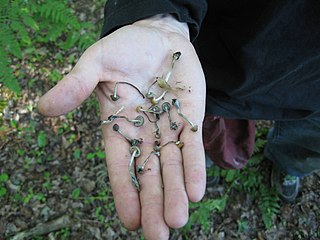
Psilocybe quebecensis is a moderately active hallucinogenic mushroom in the section Aztecorum, having psilocybin and psilocin as main active compounds. Native to Quebec, it is the most northern known psilocybin mushroom after psilocybe semilanceata in northern Scandinavia. Macroscopically this mushroom somewhat resembles Psilocybe baeocystis.
The elm cultivar Ulmus 'Variegata Nova' was first listed by Nicholson in Kew Hand-List Trees and Shrubs, 2: 137, 1896, as Ulmus campestris var. variegata nova, but without description. The tree was considered "possibly U. carpinifolia" (:minor) by Green.
The Duke of Bedford's vole is a species of rodent in the family Cricetidae. It is found only in mountainous parts of central China. It is a rare species and the International Union for Conservation of Nature has assessed its conservation status as being "vulnerable".

The small lappet moth is a moth in the family Lasiocampidae. The species was first described by Carl Linnaeus in his 1758 10th edition of Systema Naturae. It is found throughout Europe and parts of Asia.
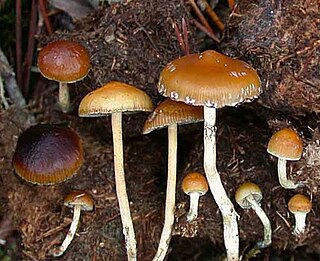
Psilocybe fimetaria is a psilocybin mushroom, having psilocybin and psilocin as main active compounds.

Orthosia populeti, the lead-coloured drab, is a moth of the family Noctuidae. It is found in Europe.

Eudonia truncicolella is a species of moth of the family Crambidae described by Henry Tibbats Stainton in 1849. It is found in China, Japan west to Europe.

Psilocybe caerulescens, also known as landslide mushroom, is a psilocybin mushroom having psilocybin and psilocin as main active compounds. Along with Psilocybe mexicana and Psilocybe aztecorum, it is one of the mushrooms likely to have been used by the Aztecs and is currently used by Mazatec shamans for its entheogenic properties.

Epinotia solandriana is a moth of the family Tortricidae. It is found in Europe, China, Korea, Japan, and Russia.

Dasystoma salicella, sometimes also known as the blueberry leafroller, is a moth of the family Lypusidae. It is endemic to Europe, but is an introduced species in North America.

Spitakavor Church ; literally meaning white-colored church, is a 13th-century partly ruined Armenia church located at the edge of a gorge in the town of Ashtarak, Aragatsotn Province, Armenia.

Stigmella luteella is a moth of the family Nepticulidae. It is found in all of Europe, except the Iberian Peninsula and the Balkan Peninsula.

Opor is a type of dish cooked and braised in coconut milk from Indonesia, especially from Central Java. In Indonesia the term 'opor' refers to the method of cooking in coconut milk. Opor is a popular dish for lebaran or Eid ul-Fitr, usually eaten with ketupat and sambal goreng ati. In Yogyakarta chicken or egg opor is often eaten with gudeg and rice.
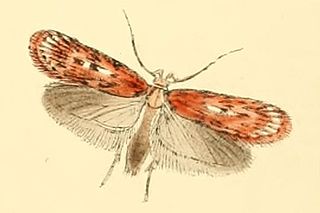
Depressaria pulcherrimella is a moth of the family Depressariidae. It is found in most of Europe, except the Balkan Peninsula.

Aproaerema anthyllidella is a moth of the family Gelechiidae. It is found in most of Europe, Kyrgyzstan, Iran and North America.
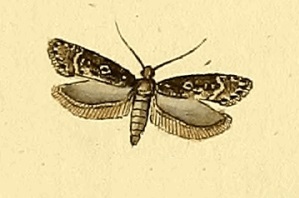
Gelechia sororculella, the dark-striped groundling, is a moth of the family Gelechiidae. It is widely distributed from Europe, throughout Siberia to the Russian Far East.
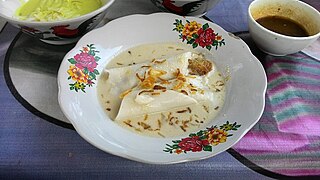
Burgo is an Indonesian folded rice pancake served in savoury whitish coconut milk-based soup, flavoured with fish, and sprinkled with fried shallots. The dish is one of the regional specialty of Palembang, the capital of South Sumatra, Indonesia. In Palembang, burgo is a popular choice for breakfast. Burgo is quite similar with lakso, although lakso is thick rice noodles and its soup has yellowish color acquired from turmeric.

Lakso is a spicy Indonesian noodle dish served in savoury yellowish coconut milk-based soup, flavoured with fish, and sprinkled with fried shallots. The dish is one of the regional specialty of Palembang, the capital of South Sumatra, Indonesia.

Miller's langur, also known as Miller's grizzled langur or Kutai grey langur, is a species of leaf monkey. It is endemic to East Kalimantan on the island of Borneo in Indonesia. It is one of the world's most endangered primates, and was at one time thought to be extinct, until it was rediscovered in 2012.

















